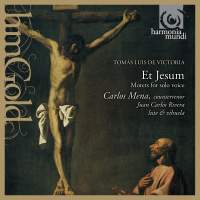Texte paru dans: / Appeared in: |
|
 |
Outil de traduction (Très approximatif) |
|
Reviewer: Fabrice Fitch
Along with his famous Mass settings, Victoria's motets are such mainstays of the repertory that throwing a new light on them is a risky business. How much 'tweaking' can they take? In Victoria's time, intabulations - an arrangement for plucked instrument of a choral piece - were a way for music lovers to experience their favourite music for themselves. But adding a soloist radically changes the dynamic: sacred choral music becomes domestic chamber music. This is the transformation envisioned by Carlos Mena. All the transcriptions are drawn from prints of the period; so, for all the surprises in store, Victoria would have been familiar with the style of Mena's performances.
The recording provides a forceful answer to those who would question the present-day value of such intabulations. Victoria's music is transfigured. It is remarkable just how much of the original polyphony is retained in transcription, and its song-like qualities are only enhanced by the focus on a particular voice. The comparison with chamber music is made explicit in several selections for which the voice and lute are joined by a cornet. The lovely Duo Semphi'l1l, with its treble-dominated texture, seems ideally suited to this treatment. Apart from the obvious word-painting, the cornet's surprise entry puts one in mind of the very similar moment in the Duo Seraphim of Monteverdi's 1610 Vespers: a small point, but it shows how imaginative decisions can vindicate an apparently off-beat project. Most of the credit belongs to the performers, for this project clearly means much to them. It needs a special voice to focus the attention so clearly on itself, and Mena's fits the bill. He has an extraordinary range: the break in the lower register is virtually imperceptible, and in Iste Sanctus he takes the alto line completely convincingly. In the middIe and upper ranges his tone is very rounded, full and clear, with no hint of strain; rather like a cornet, in fact. His use of ornamentation is discreet and just sufficient to spring the occasional surprise on those who know the music well.
Juan Carlos Rivera is a fine accompanist when he needs to be, but elsewhere he can let Mena take centre stage without himself disappearing from the texture: after all, the solo line is only one of several in the composer's original conception, and depends on the others for its intelligibility (the two versions of Domine, non sunt dignus, the one for solo lute, the other with voice, show both combinations off at their best). Rivera's own solos are mostly drawn from intabulations of Victoria's Mass music: yet more evidence of its versatility. As one for whom Victoria's music is not quite 'Desert Island' material, I can testify to the charm of this particular incarnation; I suspect that those who dislike the 'churchy' manner in which the music is so often staged will find it revelatory.
|
|
|
|
|
|
Cliquez l'un ou l'autre
bouton pour découvrir bien d'autres critiques de CD |
|




